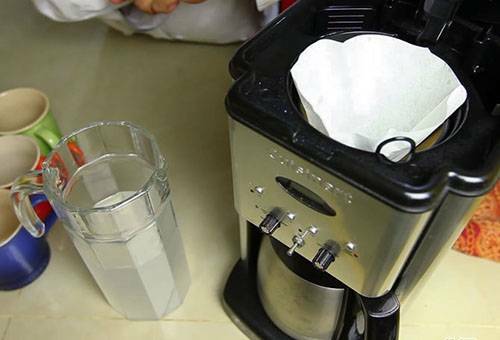Contents:
- We clean the case of the espresso machine and all the extractable parts
- Get rid of the
- scale
Some nuances How pleasant it is to cheer up a fresh, inviting, enchanting coffee drink in the morning. .. Many people around the world start their day with coffee, and some of them use itfor this special machines, sometimes without knowing how to properly clean the espresso machine. We tried to make available the details of the cleaning process in detail.
All the work we have divided into two stages, the first of which will be much simpler than the second. Start the work is with the removal of visible impurities, additional washing of all that can be extracted. Continuation will be the flushing of scale, accumulated during operation.

We clean the case of the espresso machine and all extractable parts of
. Before removing the scale, we clean the case. To do this, use either a slightly moist sponge, or a slightly soaked in a rag, preferably a synthetic one. It is undesirable and not recommended to use to remove stale spots( if any) various cleaning and cleaning products, even the weakest and "harmless" ones. In addition to the hull at this stage, it is worth cleaning and all that could be very dirty and can be extracted without difficulty. Different models of coffee machines are arranged differently, and therefore it is impossible to say which specific details it is worth trying to extract. We only point out that if possible, we need to wash the part where the grains are poured - very often they accumulate a lot of dust or some strange dirt that during the preparation of the coffee drink becomes harmless to humans, but leaves a mark on the coffee machine. In addition, it will be superfluous to wash the bowl, where the ready-made drink is poured, especially if it is not done every time after cooking.
Some coffee machines are initially equipped with the ability to easily remove contaminants. It is enough only to put a special tablet with cleaning substance and start the cooking process - smart technology will do everything for the owners.
But this question can not be considered finished - even if the technique looks like clean and looks clean, scum can accumulate inside, from which it is necessary to get rid.

We are getting rid of the
scale. Despite the fact that the technique has moved far ahead in its development, sometimes the simplest, so-called."Grandfather's" methods show themselves to be the most practical in solving a particular problem. The same applies to scale. A means for cleaning the coffee machine becomes a simple citric acid! Most of the owners of this substance is familiar not by hearsay. Nevertheless, in the case of such expensive equipment as a coffee machine, it is worthwhile to paint the algorithm of actions in the most detail.
- Descaling is our key goal. Initially, this requires only two components - boiling water and citric acid. As a result of the chemical reaction, a new substance is obtained, also an acid that reacts with the alkali. The school course of chemistry called such a neutralization of the acid with alkali and vice versa - alkali acid. Even in cleaning household appliances there are scientific examples. ..
- First, a liter of hot water is poured into the coffee machine, and citric acid is added to it. Typically 30 grams of acid goes per liter, but there are times when this amount is small and you need to create a more concentrated solution by simply increasing the dosage of citric acid.
- Immediately before the beginning of the cleaning it will not be superfluous to check whether there is a coffee drink, thickening or other things somewhere, which obviously hinders the cleaning process. This is very important: we are trying to get rid of descaling, and cleaning up the coffee will not do the job.
- Now you can also turn on the machine to clean the hydraulic system of the coffee machine from scale with the use of lemon liquid, which we poured into the tank beforehand. So, the machine turns on, but only a little water is passed through the system - about 150-200 grams. After that, the technician turns off, and the hot water tap on it remains open. After a short time( 5-7 minutes), the operation is repeated. Such actions continue until the car runs out of water. In this case, we can assume that there was no scale in the car. Now it is necessary to rinse the espresso machine in order not to drink coffee after a while with the taste of citric acid.
- At this step, the usual operations are performed, the only nuance is - no need to lay coffee, the machine needs to be washed with plain water, and if time allows - "weld" the water twice. Of course, before the second time the water should be replaced.
Of course, after descaling, the sediment will again appear on the entire hydraulic system. .. But, using this algorithm, you will also cope with its removal next time without even using special cleaning agents.

Some nuances of
Above we have described the simplest and cheapest method of descaling, but, of course, there are others. For example, it is not necessary to use citric acid for cleaning: in stores you can find special decalcifying agents, i.e. preparations, whose role is the removal of calcium deposits on the surface of the parts of the espresso machine. But not always these cleaning agents are available to the owners, and it is necessary to clean the machine. In addition, many simply do not trust all these "newfangled tricks", preferring to clean the technique in the same way as the owners of the old school have cleaned and cleaned.
So, the question of how to clean the coffee machine no longer scares the unknown. We laid out the process of cleaning the apparatus, both removing scale, cleaning the body and various parts that are constantly involved in the preparation of an invigorating drink. We very much hope that the operations carried out by our advice have benefited your coffee machine and now the morning coffee will be even more delicious and, accordingly, will further delight the owners. Successful use and cheerful days!
